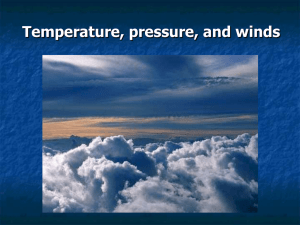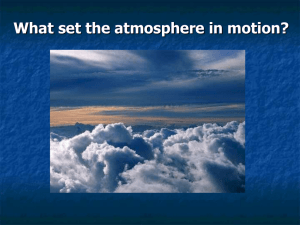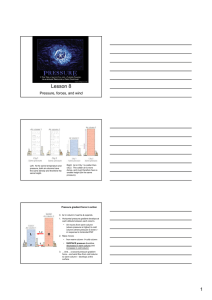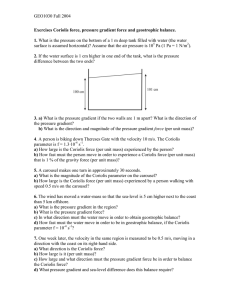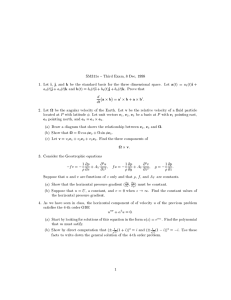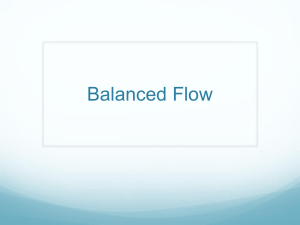Chapter 7 Forces and Force Balance
advertisement
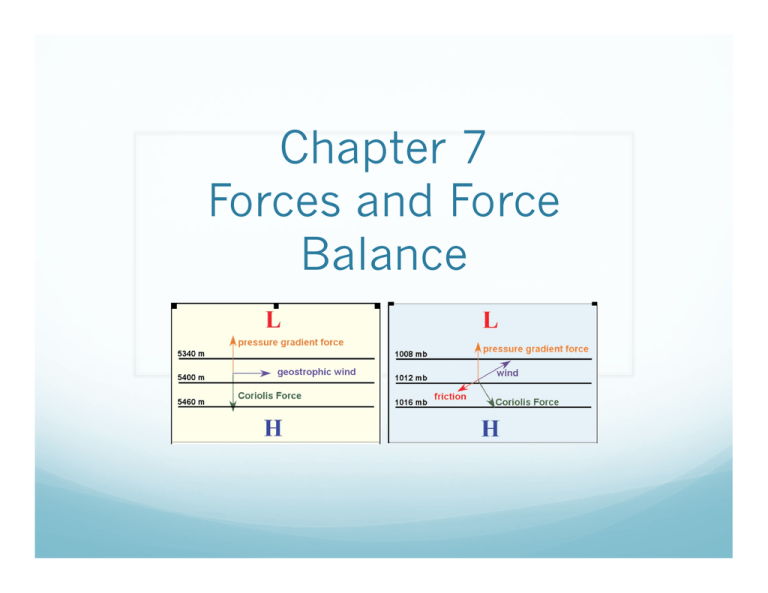
Chapter 7 Forces and Force Balance Forces that affect atmospheric motion Why does air move and what controls the speed and direction of its movement? Four forces that control movement of air: Pressure gradient force Gravitational force Frictional force Coriolis force What is a force? A force can be though of as a push or pull on an object The pressure gradient force Pressure gradient – the rate at which pressure changes with distance How is a pressure gradient created? What happens to an air parcel that exists in the presence of a pressure gradient? Pressure gradient force (PGF) – the force applied on an air parcel due to pressure difference On a surface weather map the PGF is always perpendicular to the isobars and points from high to low pressure. Recall: The PGF is large when the isobars are closely spaced and small when the isobars are spaced far apart. March 1993 Superstorm What pressure features do you see on this map? Low pressure center VA coast Where is PGF largest on this map? Where isobars are close together In what direction does the PGF act? High to low Surface sea level pressure map PGF and wind speed The PGF increases as the pressure gradient becomes larger (isobars are close together). How does this affect wind speed? The wind speed will increase as the horizontal pressure gradient, and horizontal PGF, increases. Sample horizontal pressure gradients: Consider the vertical PGF We can consider both horizontal and vertical pressure gradients. How large is the vertical pressure gradient? Estimate it based on our knowledge of the depth of the atmosphere ~1000mb total and ~200km depth = 5 mb/km How does the magnitude of the vertical pressure gradient compare to the magnitude of the sample horizontal pressure gradients listed above? In what direction does the vertical PGF act? From high to low = upward Why doesn’t the vertical PGF cause all of the air to accelerate away from the surface of the earth? The Gravitational Force The earth exerts a gravitational pull on the atmosphere that is always directed down towards the center of the earth. This helps counter the vertical PGF so our air doesn’t escape from our atmosphere The Frictional Force Frictional force – a drag force acting in a direction opposite the motion of the air We can think of the frictional force as being caused by the mixing of air parcels moving at different speeds. This mixing is referred to as turbulence. What causes turbulence in the atmosphere? Sources of turbulence Mechanical turbulence occurs when air encounters obstructions on the surface. Mechanical turbulence is larger over a rough surface than over a smooth surface. Thermal turbulence occurs when heated air rises and mixes with the air above. Thermal turbulence is most common during the day. Shear induced turbulence occurs when the wind speed changes rapidly over a short distance. Shear induced turbulence is largest when the wind shear is large. Friction near the surface Turbulence, and thus the frictional force, tends to be most important near the surface of the earth, and rapidly decrease as you move away from the surface. But what about when we encounter turbulence flying in an airplane? Where in the atmosphere does that occur? Which type of turbulence might still occur higher in altitude away from the surface? Friction layer (boundary layer) – the atmospheric layer in which friction is an important force How deep is the friction layer? Depends on time of day (heating), surface roughness, stability and wind speed. Few 100-1000s of meters The Coriolis Force The Coriolis force is an apparent force that arises due to the rotation of the earth. The Coriolis force is due to conservation of angular momentum and the effects of the centrifugal force. Facts about Coriolis The Coriolis force causes objects to turn to the right of their direction of motion in the Northern hemisphere To the left in the Southern hemisphere! The Coriolis force can affect the direction of motion of an object, but cannot change the speed of the object. The Coriolis force is strongest for fast moving objects and zero for objects that are not moving. The Coriolis force is zero at the equator and increases to a maximum at the poles. The Coriolis force is most important for air movement over large distances and becomes insignificant for small scale circulations Clicker Question Of the four forces that affect the motion of air in our atmosphere, which is to thank for opposing the vertical pressure gradient force so that we have air in our atmosphere? A. Horizontal pressure gradient force B. Gravitational force C. Frictional force D. Coriolis force Clicker Question Which force is most important near the surface than in the upper atmosphere? A. Horizontal pressure gradient force B. Gravitational force C. Frictional force D. Coriolis force Clicker Question The Coriolis force _________. A. always causes moving objects to turn to the right of B. C. D. E. their direction of motion can only affect the direction of a moving object, not its speed is zero for non-moving objects All of the above Only b and c Clicker Question True or false: The Coriolis force is zero at the poles and strongest at the equator. A. True B. False Newton’s Laws of Motion Newton’s First Law of Motion – an object at rest will remain at rest and an object in motion will remain in motion traveling at a constant speed in a straight line as long as no force is exerted on the object. Acceleration – a change in speed and/or direction Newton’s Second Law of Motion – the force (F) exerted on an object equals its mass (m) times its acceleration (a) F = m x a A push on a light object causes a large acceleration. A push on a heavy object causes a small acceleration. How do these laws apply? In the atmosphere multiple forces act on the air. The sum of these forces gives the net acceleration of the air. For our discussion of the atmosphere we will consider the forces that result in horizontal and vertical accelerations of the air separately. Vertical motion Acceleration = vertical PGF + gravitational force What kind of acceleration do these forces yield? Almost none—there is a near balance This balance is called hydrostatic balance Hydrostatic balance – the upward directed PGF is exactly balanced by the downward directed gravitational force The atmosphere is almost always in hydrostatic balance. The most common exception is in strong thunderstorms. Horizontal Motion For horizontal motions we will think about air within the boundary layer and air above the boundary layer separately. Horizontal motion above the boundary layer: Acceleration = horizontal PGF + Coriolis force Horizontal motion within the boundary layer: Acceleration = horizontal PGF + Coriolis force + frictional force Why do we have an additional force to consider within the boundary layer? Force Balances Hydrostatic balance – vertical PGF balanced by the gravitational force Geostrophic balance – the PGF is exactly balanced by the Coriolis force Geostrophic Balance How does air, that is initially at rest, come into geostrophic balance? Geostrophic Wind Geostrophic wind – the wind that would exist if the atmosphere were in geostrophic balance. The geostrophic wind flows parallel to straight isobars (or height contours on a constant pressure map) and its speed increases as the pressure gradient increases. In the Northern hemisphere the geostrophic wind is directed such that higher pressure (or higher heights on a constant pressure map) are to the right of the geostrophic wind direction. What is the geostrophic wind direction at each location? Which is stronger: A or C? D A C B In the real world Above the boundary layer the atmosphere is nearly in geostrophic balance, but rarely exactly in geostrophic balance. Geostrophic balance at A? B? No, not exact What conditions are required for the atmosphere to be in exact geostrophic balance? Isobars are straight AND parallel Clicker Question True or false: Geostrophic balance is a balance between the vertical pressure gradient force and the gravitational force. A. True B. False Clicker Question True or false: The atmosphere is always in hydrostatic balance. A. True B. False Clicker Question Which of the following forces affect horizontal motion within the boundary layer? A. Horizontal pressure gradient force B. Coriolis C. Friction D. All of the above E. Only a and b Clicker Question The Coriolis force causes moving objects to turn _______. A. Right in both the northern and southern hemispheres B. Left in both the northern and southern hemispheres C. Right in the northern hemisphere, left in the southern hemisphere D. Left in the northern hemisphere, right in the southern hemisphere Geostrophic Balance and the Jet Stream Jetstream – a narrow band of strong winds that encircle the earth in the mid-latitudes. The jetstream is typically 200 to 300 miles wide and located between 250 mb and 500 mm Up to 3 jetstreams can exist between the equator and the pole: Subtropical jetstream Polar jetstream Arctic jetstream Jetstreak – a region of exceptionally strong winds in the jetstream. Where is the jet stream on this map? Recall: Constant pressure surfaces How does the height of a constant pressure surface change as you move from warm to cold air? How does the pressure change as you move from left to right in this figure, at an altitude of 5400 m? Jet streams and temperature gradients The slope of a constant pressure surface, and thus the horizontal pressure gradient, is largest in the upper troposphere above the region of largest horizontal temperature gradient. The geostrophic wind speed will increase as the slope of the constant pressure surface increases. Constant pressure surfaces, in the upper troposphere, generally slope downward from the equator to the pole. In what direction will the geostrophic wind blow in the midlatitudes if the constant pressure surfaces slope downward from the equator to the pole? West to East! Fronts and Jet Streams How does the slope of the constant pressure surfaces change as you move up from 1000 mb to 300 mb? Relative to the warm and cold air, in what direction does the 300 mb surface slope down towards? Why is the jetstream (marked by the J) located where it is in this picture? Slope is steepest!
